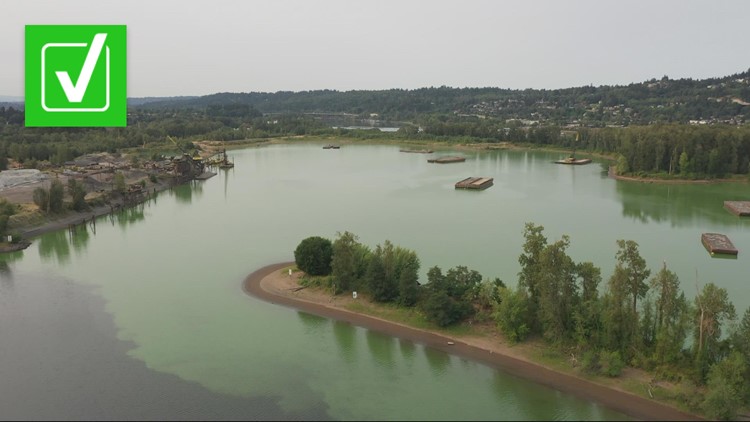PORTLAND, Ore. — It's become something of an unsavory summer tradition in Portland: Just when the hottest and sunniest weather arrives, emergency alerts go out from the city and the Oregon Health Authority, warning people to stay out of the Willamette River.
The closures are the exception rather than the rule; the Willamette River's water quality has improved dramatically in recent decades, and under normal circumstances the river is perfectly safe for swimming. But there are two big exceptions: sewer overflow incidents and toxic algae bloom events. The summertime closures are typically due to the latter.
The blooms cover the surface of the river with what looks like a layer of green slime through the downtown area, and the algae — technically cyanobacteria — produces toxins that are harmful to humans in high concentrations. The events have become increasingly frequent, and KGW viewer Roger Aldrich recently sent in this question:
Last fall Portland apparently figured out that Ross Island was the source of our algae blooms. Is the city, state, or anybody going to fix this situation before another deadly bloom? Were they even truthful about the blooms in the first place?
THE QUESTION
Is Ross Island the source of Portland's algae blooms in the Willamette River?
THE SOURCES
THE ANSWER
Yes, the Ross Island lagoon is a major source of Portland's algae blooms. It's not the only source, but it's been the most common offender in recent years, and it's typically the main source of blooms in the downtown area.
WHAT WE FOUND
Algae blooms have become an increasingly frequent problem along the Willamette River in Portland, with the public warnings often singling out Ross Island as the source or the most-toxic area. The specific problem is the Ross Island lagoon, which sits in the center of the island but is still connected to the river on one side.
KGW spoke last summer with Dr. Desiree Tullos at Oregon State University, who explained that algae blooms are caused by a combination of warm temperatures, abundant nutrients and stagnant water. The first two factors are manmade in a broad sense because they're both made worse by climate change and industrial pollution, but in Portland's case the stagnant water factor has a much more direct manmade cause.
"The lagoon used to be three separate islands," Tullos said. "The river flowed through those islands, and then over a century ago or so, people started mucking around in the river. They built an embankment, they extracted a bunch of gravel. And essentially what that did, it created a really deep hole in the river that was just barely connected to the river, through a lagoon."
The lagoon isn't the only source of algae blooms near Portland — recent incidents have also centered around Willamette Cove and Cathedral Park in North Portland — but since the Ross Island lagoon is located immediately upriver from the downtown area, it tends to be the source for blooms spotted in Portland.
An environmental group sued the Oregon Department of Environmental Quality last year, alleging that the agency violated the Clean Water Act by allowing Ross Island Sand & Gravel's activities to turn the lagoon into an algae breeding ground.
Solutions in the works
The blooms in the lagoon have essentially become an annual summertime event, and there won't be any changes in time to prevent another round this year. However, multiple groups have been working for years to tackle the problem.
The US Geological Survey installed a new water quality monitoring station on the dock by OMSI last year, aimed at tracking the status of blooms as they spread out from Ross Island.
And the Human Access Project, a river recreation advocacy group founded by Willie Levenson, has been at the center of an effort to come up with physical solutions to prevent the blooms, working with Tullos and OSU and other groups.
One of the leading ideas is to slice a channel through the island to allow the river to flow freely through the lagoon area. Another is to pump colder water from the lagoon pit up to the surface, disrupting the warmer conditions that allow algae to grow.
Sen. Jeff Merkley has also been involved, pushing last year for a federal environmental appropriations bill to include $100,000 for the Human Access Project to help mitigate the Ross Island lagoon problem. A report from the Tullos and Levenson mentions that the federal money will be enough to get the project to a 30% design stage.
Got a question or a story about Portland or Oregon that you'd like us to VERIFY? Drop us a line at verify@kgw.com.



